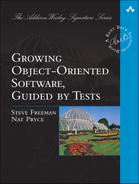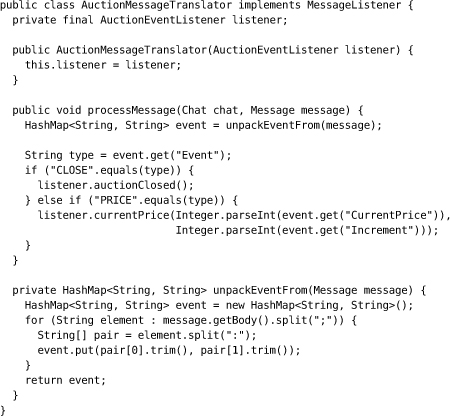Chapter 12. Getting Ready to Bid
In which we write an end-to-end test so that we can make the Sniper bid in an auction. We start to interpret the messages in the auction protocol and discover some new classes in the process. We write our first unit tests and then refactor out a helper class. We describe every last detail of this effort to show what we were thinking at the time.
An Introduction to the Market
Now, to continue with the skeleton metaphor, we start to flesh out the application. The core behavior of a Sniper is that it makes a higher bid on an item in an auction when there’s a change in price. Going back to our to-do list, we revisit the next couple of items:
• Single item: join, bid, and lose. When a price comes in, send a bid raised by the minimum increment defined by the auction. This amount will be included in the price update information.
• Single item: join, bid, and win. Distinguish which bidder is currently winning the auction and don’t bid against ourselves.
We know there’ll be more coming, but this is a coherent slice of functionality that will allow us to explore the design and show concrete progress.
In any distributed system similar to this one there are lots of interesting failure and timing issues, but our application only has to deal with the client side of the protocol. We rely on the underlying XMPP protocol to deal with many common distributed programming problems; in particular, we expect it to ensure that messages between a bidder and an auction arrive in the same order in which they were sent.
As we described in Chapter 5, we start the next feature with an acceptance test. We used our first test in the previous chapter to help flush out the structure of our application. From now on, we can use acceptance tests to show incremental progress.
A Test for Bidding
Starting with a Test
Each acceptance test we write should have just enough new requirements to force a manageable increase in functionality, so we decide that the next one will add some price information. The steps are:
1. Tell the auction to send a price to the Sniper.
2. Check the Sniper has received and responded to the price.
3. Check the auction has received an incremented bid from Sniper.
To make this pass, the Sniper will have to distinguish between Price and Close events from the auction, display the current price, and generate a new bid. We’ll also have to extend our stub auction to handle bids. We’ve deferred implementing other functionality that will also be required, such as displaying when the Sniper has won the auction; we’ll get to that later. Here’s the new test:
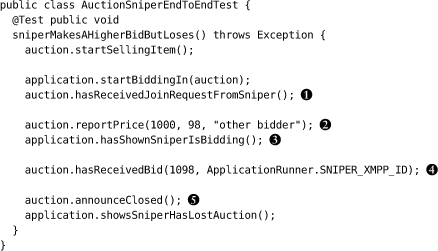
We have three new methods to implement as part of this test.
![]() We have to wait for the stub auction to receive the
We have to wait for the stub auction to receive the Join request before continuing with the test. We use this assertion to synchronize the Sniper with the auction.
![]() This method tells the stub auction to send a message back to the Sniper with the news that at the moment the price of the item is 1000, the increment for the next bid is 98, and the winning bidder is “other bidder.”
This method tells the stub auction to send a message back to the Sniper with the news that at the moment the price of the item is 1000, the increment for the next bid is 98, and the winning bidder is “other bidder.”
![]() This method asks the
This method asks the ApplicationRunner to check that the Sniper shows that it’s now bidding after it’s received the price update message from the auction.
![]() This method asks the stub auction to check that it has received a bid from the Sniper that is equal to the last price plus the minimum increment. We have to do a fraction more work because the XMPP layer constructs a longer name from the basic identifier, so we define a constant
This method asks the stub auction to check that it has received a bid from the Sniper that is equal to the last price plus the minimum increment. We have to do a fraction more work because the XMPP layer constructs a longer name from the basic identifier, so we define a constant SNIPER_XMPP_ID which in practice is sniper@localhost/Auction.
![]() We reuse the closing logic from the first test, as the Sniper still loses the auction.
We reuse the closing logic from the first test, as the Sniper still loses the auction.
Extending the Fake Auction
We have two methods to write in the FakeAuctionServer to support the end-to-end test: reportPrice() has to send a Price message through the chat; hasReceivedBid() is a little more complex—it has to check that the auction received the right values from the Sniper. Instead of parsing the incoming message, we construct the expected message and just compare strings. We also pull up the Matcher clause from the SingleMessageListener to give the FakeAuctionServer more flexibility in defining what it will accept as a message. Here’s a first cut:
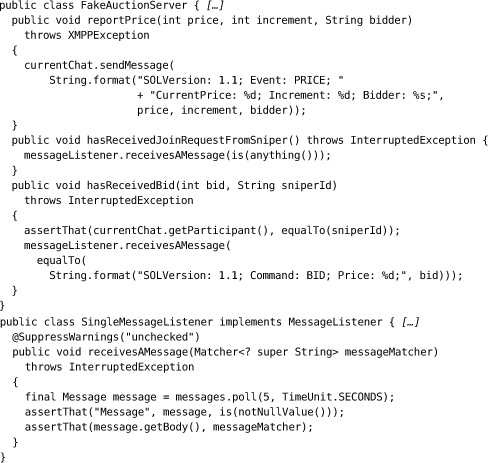
Looking again, there’s an imbalance between the two “receives” methods. The Join method is much more lax than the bid message, in terms of both the contents of the message and the sender; we will have to remember to come back later and fix it. We defer a great many decisions when developing incrementally, but sometimes consistency and symmetry make more sense. We decide to retrofit more detail into hasReceivedJoinRequestFromSniper() while we have the code cracked open. We also extract the message formats and move them to Main because we’ll need them to construct raw messages in the Sniper.
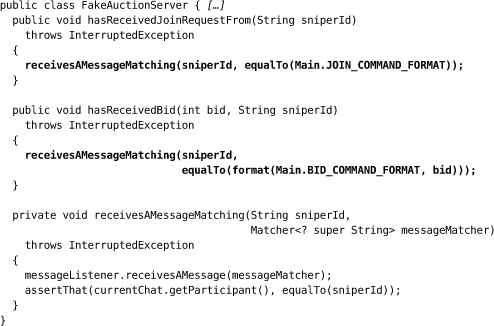
Notice that we check the Sniper’s identifier after we check the contents of the message. This forces the server to wait until the message has arrived, which means that it must have accepted a connection and set up currentChat. Otherwise the test would fail by checking the Sniper’s identifier prematurely.
We adjust the end-to-end tests to match the new API, watch the test fail, and then add the extra detail to the Sniper to make the test pass.

A Surprise Failure
Finally we write the “checking” method on the ApplicationRunner to give us our first failure. The implementation is simple: we just add another status constant and copy the existing method.
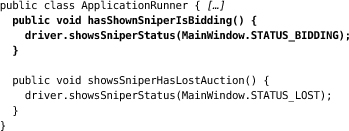
We’re expecting to see something about a missing label text but instead we get this:

and this on the error stream:
After some investigation we realize what’s happened. We’ve introduced a second test which tries to connect using the same account and resource name as the first. The server is configured, like Southabee’s On-Line, to reject multiple open connections, so the second test fails because the server thinks that the first is still connected. In production, our application would work because we’d stop the whole process when closing, which would break the connection. Our little compromise (of starting the application in a new thread) has caught us out. The Right Thing to do here is to add a callback to disconnect the client when we close the window so that the application will clean up after itself:

Now we get the failure we expected, because the Sniper has no way to start bidding.
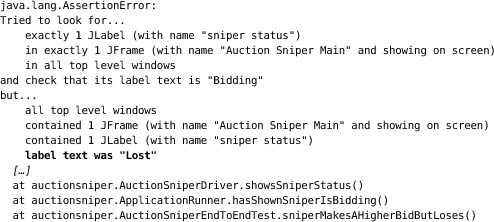
Outside-In Development
This failure defines the target for our next coding episode. It tells us, at a high level, what we’re aiming for—we just have to fill in implementation until it passes.
Our approach to test-driven development is to start with the outside event that triggers the behavior we want to implement and work our way into the code an object at a time, until we reach a visible effect (such as a sent message or log entry) indicating that we’ve achieved our goal. The end-to-end test shows us the end points of that process, so we can explore our way through the space in the middle.
In the following sections, we build up the types we need to implement our Auction Sniper. We’ll take it slowly, strictly by the TDD rules, to show how the process works. In real projects, we sometimes design a bit further ahead to get a sense of the bigger picture, but much of the time this is what we actually do. It produces the right results and forces us to ask the right questions.
Infinite Attention to Detail?
We caught the resource clash because, by luck or insight, our server configuration matched that of Southabee’s On-Line. We might have used an alternative setting which allows new connections to kick off existing ones, which would have resulted in the tests passing but with a confusing conflict message from the Smack library on the error stream. This would have worked fine in development, but with a risk of Snipers starting to fail in production.
How can we hope to catch all the configuration options in an entire system? At some level we can’t, and this is at the heart of what professional testers do. What we can do is push to exercise as much as possible of the system as early as possible, and to do so repeatedly. We can also help ourselves cope with total system complexity by keeping the quality of its components high and by constantly pushing to simplify. If that sounds expensive, consider the cost of finding and fixing a transient bug like this one in a busy production system.
The AuctionMessageTranslator
Teasing Out a New Class
Our entry point to the Sniper is where we receive a message from the auction through the Smack library: it’s the event that triggers the next round of behavior we want to make work. In practice, this means that we need a class implementing MessageListener to attach to the Chat. When this class receives a raw message from the auction, it will translate it into something that represents an auction event within our code which, eventually, will prompt a Sniper action and a change in the user interface.
We already have such a class in Main—it’s anonymous and its responsibilities aren’t very obvious:
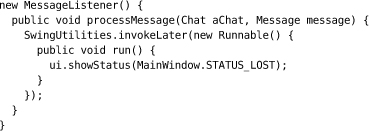
This code implicitly accepts a Close message (the only kind of message we have so far) and implements the Sniper’s response. We’d like to make this situation explicit before we add more features. We start by promoting the anonymous class to a top-level class in its own right, which means it needs a name. From our description in the paragraph above, we pick up the word “translate” and call it an AuctionMessageTranslator, because it will translate messages from the auction.
The catch is that the current anonymous class picks up the ui field from Main. We’ll have to attach something to our newly promoted class so that it can respond to a message. The most obvious thing to do is pass it the MainWindow but we’re unhappy about creating a dependency on a user interface component. That would make it hard to unit-test, because we’d have to query the state of a component that’s running in the Swing event thread.
More significantly, such a dependency would break the “single responsibility” principle which says that unpacking raw messages from the auction is quite enough for one class to do, without also having to know how to present the Sniper status. As we wrote in “Designing for Maintainability” (page 47), we want to maintain a separation of concerns.
Given these constraints, we decide that our new AuctionMessageTranslator will delegate the handling of an interpreted event to a collaborator, which we will represent with an AuctionEventListener interface; we can pass an object that implements it into the translator on construction. We don’t yet know what’s in this interface and we haven’t yet begun to think about its implementation. Our immediate concern is to get the message translation to work; the rest can wait. So far the design looks like Figure 12.1 (types that belong to external frameworks, such as Chat, are shaded):
Figure 12.1 The AuctionMessageTranslator

The First Unit Test
We start with the simpler event type. As we’ve seen, a Close event has no values—it’s a simple trigger. When the translator receives one, we want it to call its listener appropriately.
As this is our first unit test, we’ll build it up very slowly to show the process (later, we will move faster). We start with the test method name. JUnit picks up test methods by reflection, so we can make their names as long and descriptive as we like because we never have to include them in code. The first test says that the translator will tell anything that’s listening that the auction has closed when it receives a raw Close message.
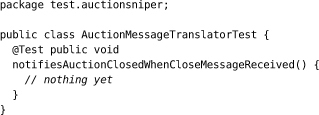
The next step is to add the action that will trigger the behavior we want to test—in this case, sending a Close message. We already know what this will look like since it’s a call to the Smack MessageListener interface.
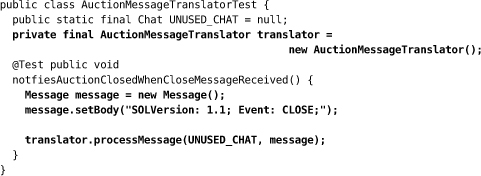
We generate a skeleton implementation from the MessageListener interface.

Next, we want a check that shows whether the translation has taken place—which should fail since we haven’t implemented anything yet. We’ve already decided that we want our translator to notify its listener when the Close event occurs, so we’ll describe that expected behavior in our test.
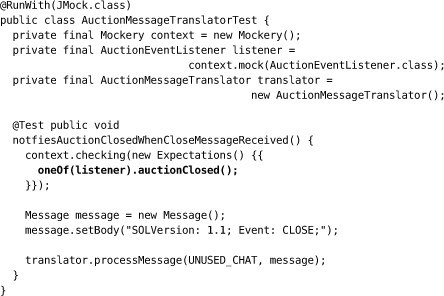
This is more or less the kind of unit test we described at the end of Chapter 2, so we won’t go over its structure again here except to emphasize the highlighted expectation line. This is the most significant line in the test, our declaration of what matters about the translator’s effect on its environment. It says that when we send an appropriate message to the translator, we expect it to call the listener’s auctionClosed() method exactly once.
We get a failure that shows that we haven’t implemented the behavior we need:

The critical phrase is this one:
expected once, never invoked: auctionEventListener.auctionClosed()
which tells us that we haven’t called the listener as we should have.
We need to do two things to make the test pass. First, we need to connect the translator and listener so that they can communicate. We decide to pass the listener into the translator’s constructor; it’s simple and ensures that the translator is always set up correctly with a listener—the Java type system won’t let us forget. The test setup looks like this:

The second thing we need to do is call the auctionClosed() method. Actually, that’s all we need to do to make this test pass, since we haven’t defined any other behavior.
![]()
The test passes. This might feel like cheating since we haven’t actually unpacked a message. What we have done is figured out where the pieces are and got them into a test harness—and locked down one piece of functionality that should continue to work as we add more features.
Closing the User Interface Loop
Now we have the beginnings of our new component, we can retrofit it into the Sniper to make sure we don’t drift too far from working code. Previously, Main updated the Sniper user interface, so now we make it implement AuctionEventListener and move the functionality to the new auctionClosed() method.
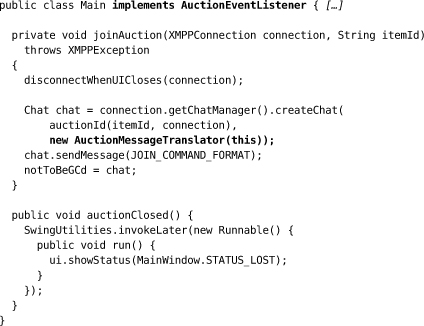
The structure now looks like Figure 12.2.
Figure 12.2 Introducing the AuctionMessageTranslator

What Have We Achieved?
In this baby step, we’ve extracted a single feature of our application into a separate class, which means the functionality now has a name and can be unit-tested. We’ve also made Main a little simpler, now that it’s no longer concerned with interpreting the text of messages from the auction. This is not yet a big deal but we will show, as the Sniper application grows, how this approach helps us keep code clean and flexible, with clear responsibilities and relationships between its components.
Unpacking a Price Message
Introducing Message Event Types
We’re about to introduce a second auction message type, the current price update. The Sniper needs to distinguish between the two, so we take another look at the message formats in Chapter 9 that Southabee’s On-Line have sent us. They’re simple—just a single line with a few name/value pairs. Here are examples for the formats again:
SOLVersion: 1.1; Event: PRICE; CurrentPrice: 192; Increment: 7; Bidder: Someone else;
SOLVersion: 1.1; Event: CLOSE;
At first, being object-oriented enthusiasts, we try to model these messages as types, but we’re not clear enough about the behavior to justify any meaningful structure, so we back off the idea. We decide to start with a simplistic solution and adapt from there.
The Second Test
The introduction of a different Price event in our second test will force us to parse the incoming message. This test has the same structure as the first one but gets a different input string and expects us to call a different method on the listener. A Price message includes details of the last bid, which we need to unpack and pass to the listener, so we include them in the signature of the new method currentPrice(). Here’s the test:
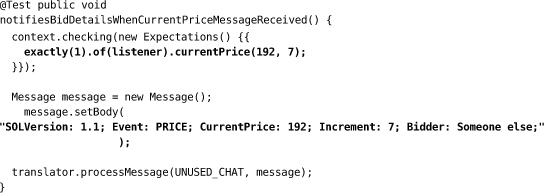
To get through the compiler, we add a method to the listener; this takes just a keystroke in the IDE:1
1. Modern development environments, such as Eclipse and IDEA, will fill in a missing method on request. This means that we can write the call we’d like to make and ask the tool to fill in the declaration for us.

The test fails.

This time the critical phrase is:
unexpected invocation: auctionEventListener.auctionClosed()
which means that the code called the wrong method, auctionClosed(), during the test. The Mockery isn’t expecting this call so it fails immediately, showing us in the stack trace the line that triggered the failure (you can see the workings of the Mockery in the line $Proxy6.auctionClosed() which is the runtime substitute for a real AuctionEventListener). Here, the place where the code failed is obvious, so we can just fix it.
Our first version is rough, but it passes the test.
This implementation breaks the message body into a set of key/value pairs, which it interprets as an auction event so it can notify the AuctionEventListener. We also have to fix the FakeAuctionServer to send a real Close event rather than the current empty message, otherwise the end-to-end tests will fail incorrectly.
![]()
Running our end-to-end test again reminds us that we’re still working on the bidding feature. The test shows that the Sniper status label still displays Joining rather than Bidding.
Discovering Further Work
This code passes the unit test, but there’s something missing. It assumes that the message is correctly structured and has the right version. Given that the message will be coming from an outside system, this feels risky, so we need to add some error handling. We don’t want to break the flow of getting features to work, so we add error handling to the to-do list to come back to it later (Figure 12.3).
Figure 12.3 Added tasks for handling errors
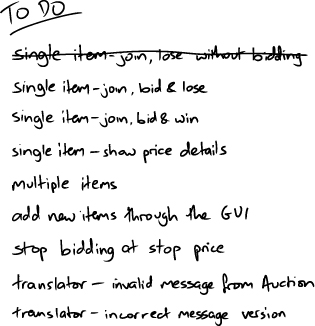
We’re also concerned that the translator is not as clear as it could be about what it’s doing, with its parsing and the dispatching activities mixed together. We make a note to address this class as soon as we’ve passed the acceptance test, which isn’t far off.
Finish the Job
Most of the work in this chapter has been trying to decide what we want to say and how to say it: we write a high-level end-to-end test to describe what the Sniper should implement; we write long unit test names to tell us what a class does; we extract new classes to tease apart fine-grained aspects of the functionality; and we write lots of little methods to keep each layer of code at a consistent level of abstraction. But first, we write a rough implementation to prove that we know how to make the code do what’s required and then we refactor—which we’ll do in the next chapter.
We cannot emphasize strongly enough that “first-cut” code is not finished. It’s good enough to sort out our ideas and make sure we have everything in place, but it’s unlikely to express its intentions cleanly. That will make it a drag on productivity as it’s read repeatedly over the lifetime of the code. It’s like carpentry without sanding—eventually someone ends up with a nasty splinter.
